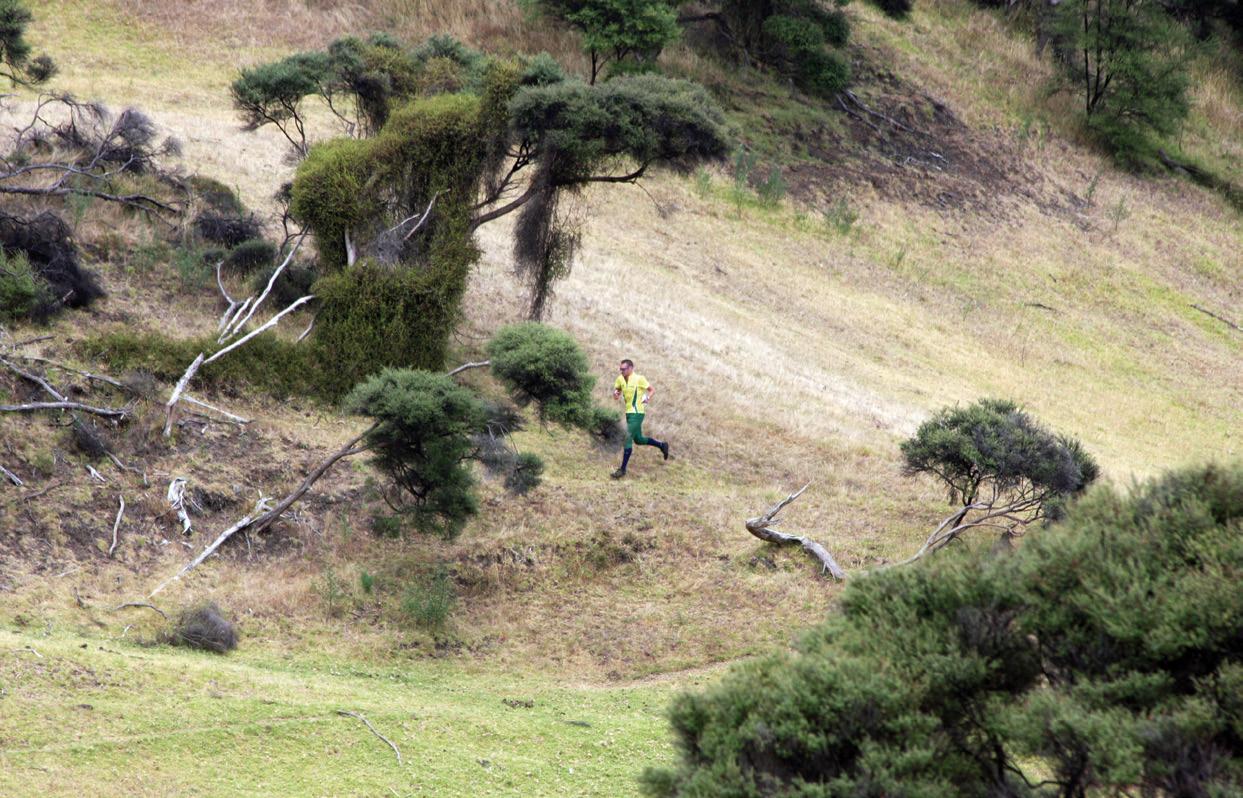
11 minute read
WAITANGI CARNIVAL, NZ
9 Events in 9 Days
Words & photos: Paul Prudhoe
(Central Coast Orienteers)
Map: Hedley Road, 1:10,000 Above: Dave Shepherd Right: Mace Neve 2008 saw the running of the third Waitangi Carnival on New Zealand’s North Island. The Waitangi Carnival was the brainchild of NZ elite orienteer Greg Flynn, who started the Carnival to coincide with New Zealand’s long weekend celebrating the signing of the Waitangi Treaty on February 6th. In 2006 Greg was coordinator for the complete event and controlled all five races. A year later, with a little more help from other NZ elites, Greg was again overall coordinator but still managed to set one race and control another. In 2007 and 2008 Simon Addison assisted Greg with many of the coordination tasks (and re-mapped Waikato University for the World Ranking event and Test match with Australia).
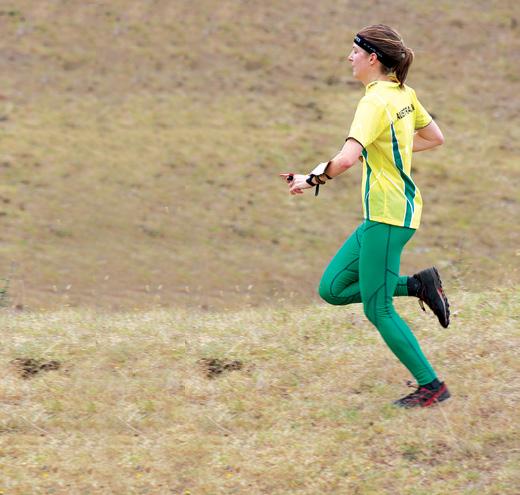
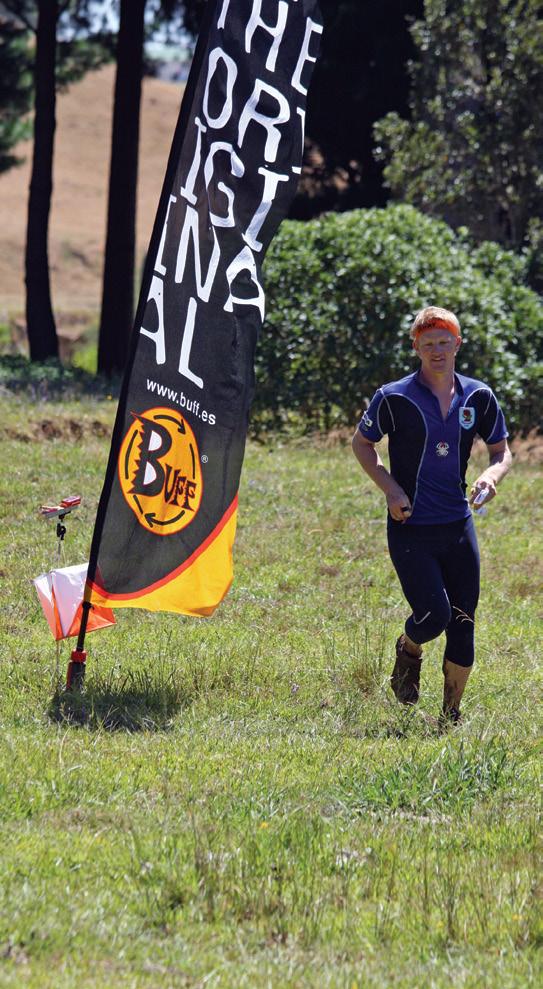

Dave Meyer at the Aramiro event


Bryan Keely at Waikato Jim Russell
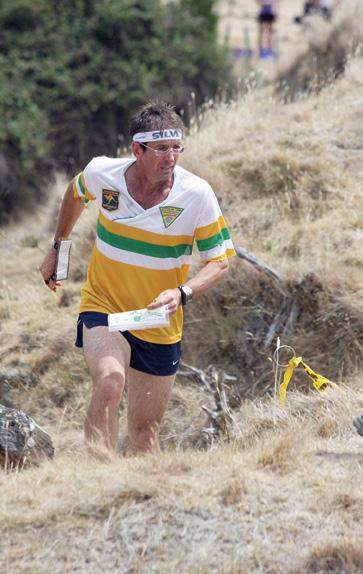

Map: Univarsity of Waikato. Scale 1:4000
Bridget Anderson and Oliver Mitchell at Waikato.
In 2007 the Carnival was based around Taupo in the Central District, and most events held within a short drive of the town. The main feature of the Waitangi Carnival has been the number of events held in a short period – perfect for orienteering junkies. In 2007, if some thought that the organisers had stretched themselves a little too far, then 2008 was going overboard – with 9 events in 9 days. To add to the challenge for the 2008 organisers, this year’s Carnival would be held in three regions – Taupo, Hamilton and (just north of) Auckland. Not satisfied with 9 events in 9 days the Waitangi Carnival organisers also added to the mix two World ranking events, a test match series with Australia, and a 5-man and 7-man night Relay event (primarily for New Zealand club teams). With so much to offer it was not surprising to see the events well attended by New Zealand orienteers, with competitors also from Australia, U.K, Finland, Russia, New Caledonia and elsewhere. Considering the proximity to Australia, the quality and number of events, it was surprising not to see more orienteers from Australia – perhaps the clash with the start of the new Australian school year deterred many.
Jo Allison, Kirsten Fairfax & Simon Uppill, tangle under a fern at Kairangi

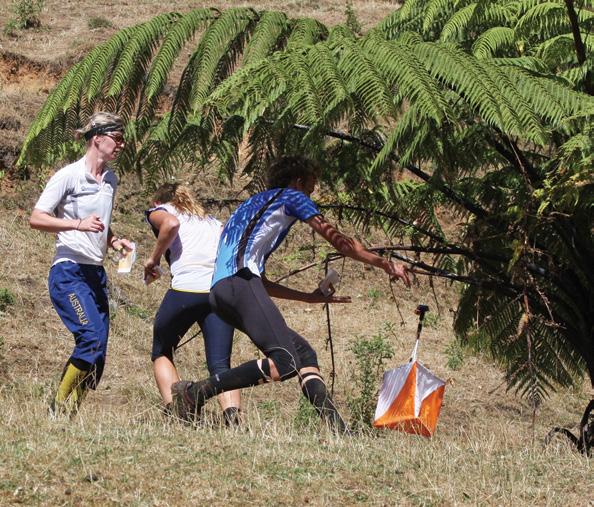
Map: Kairangi Scale 1:10,000
Dave Shepherd jumping at Kairangi.

Kairangi – Carsten Joergensen
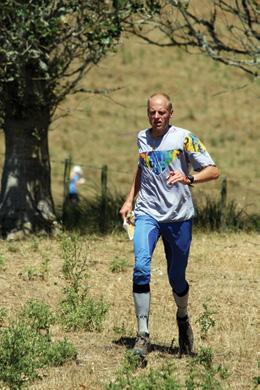

Map: Waihora Scale 1:7500
The 2008 Carnival Event 1 - The Buff (NZ) CD Middle Distance Championships
The Carnival opened with an afternoon event adjacent to Taupo airport. Part of the map was new, with a section previously used as the warm-up before Katoa Po 2007. The terrain was typical Taupo erosion gullies on fast open farmland with a few patches of forest. Of course, farmland in New Zealand means fences, and for those who have never orienteered in New Zealand, fences mean two things – they’re not marked on the map and, more importantly, they might be electric and switched on! (Is this why there weren’t so many Aussies?) New Zealand elite Karl Dravitzki won the elite Middle Distance race, with Dave Shepherd Australia’s best placed elite in third place just 31secs behind Dravitzki. Australia’s Jo Allison won the women’s elite race in 23min07sec.
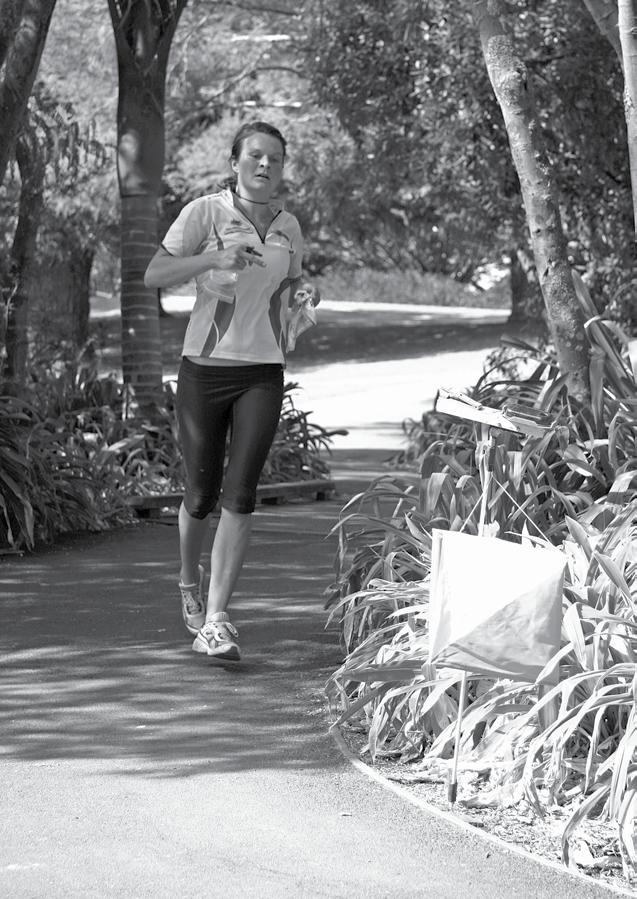
Event 2 - Katoa Po Night Relays
Katoa Po is a Maori word which translates to “all night”. The Katoa Po Relay is an annual interclub night event hosted by the Taupo Orienteering Club and is usually held on the Saturday closest to Full Moon in February or March. The event was the brainchild of Graham Teahan, a past TOC club member (and IOF Event Adviser for the World Masters Orienteering Championships to be held in NSW in October 2009). Teams of 5 and 7 runners are made up of members of mixed abilities, and mixed ages. The first event was held in 1981. The terrain for the Night Relay was described in the program as “a farm map with rolling-to-steep hills that are incised with complex gullies and other negative terrain features. There are a number of small forestry blocks in the bigger gullies”. With Australia’s elites forming three-person teams, the remaining few Australian “non-elites” at the carnival were left to put together a team. This saw Newcastle’s Margaret Peel run the first leg (against many of New Zealand’s up and coming elite’s – actually they were 10~12 year olds!). The rest of the team consisted of Australian master-mapper Eric Andrews, Australian Junior Development squad member Emily Prudhoe, QOA’s Liz Bourne, Central Coast’s Paul Prudhoe, Newcastle Orienteer Geoff Peel and running the last leg was Victorian Ted Van Geldermalsen. Suffice it to say, the team took its time getting to grips with the terrain and the map, resulting in Geoff Peel not getting to bed until after 3:00am, while Ted who ran the last leg actually went out (and finished) before Geoff! Anyone interested in a more colourful version of the race report (and the Carnival) should look up Geoff Peel’s web-blog.
Event 3 - Chasing Start - Waihora
The third event, on the morning after the night race, was a chasing start based on the times from the first event at Taupo and made for some close competition especially as the terrain was again open farmland. New Zealand’s Ross Morrison overcame a 45sec deficit to win Day 2, while the women’s overnight leader, Jo Allison, dropped to third behind two runners from Estonia. The races were made more interesting for the competitors with clever use of butterfly loops.
Event 4 - The Bivouac/Outdoor CD Sprint Distance Champs - Waikato University
The Waikato University Sprint race doubled as the first test match in the series of four between Australia and New Zealand and the first World Ranking Event for 2008. Ross Morrison dominated the men’s proceedings for the second day in a row, winning the race by 26sec. Morrison was followed in by Christchurch’s Carsten Joergensen and Australia’s David Shepherd in a race which saw temperatures in the thirties and the lead change numerous times. New Zealand’s Greta Knarston fought off Estonia’s Liis Johanson to win by 3secs and both were well ahead of Australian Jo Allison in what was the closest race of the carnival so far. Australia left New Zealand to play catch up winning the first test match 56 to 46. The match was a close battle with a draw accounting for the men’s race, 26 each, but the Australian women were too strong coming home with 30 to New Zealand’s 20.
Jasmine Neve at the Waikato University Sprint
Event 5 - Loop Race - Kairangi
Kairangi is on the edge of Mt. Manatrauti in the Waikato region and the loop race was designed to be a fun event, aimed to create fast, tight, head-to-head racing, packed with spectator value. Once again the Kiwi’s delivered on their pre-race promise. Ross Morrison stamped his authority on the Waitangi Summer Carnival winning his third race in a row. Ross’s time of 55min54secs was too much for Australia’s Simon Uppill and Glenn Meyer who finished 12secs and 42secs respectively behind Ross on a course which demanded high levels of endurance in scorching sun and strong winds. Estonia’s Liis Johanson stepped up from second place the day before to lead the women’s race from start to finish relegating New Zealand’s Piret Klade and Australia’s Jo Allison to second and third. Johanson looked at home on the Waikato hills as she completed the four loops in 59min54secs while Klade was only just off the lead in 60min10secs with Allison more than a minute back in 61min17secs. The loop race (often known as Hagaby) saw the athletes begin the race together which made tight head-tohead racing and tested nerves as the leaders ran with their rivals breathing down their necks.
Event 6 - Central Districts Championships – Aramiro
New Zealand’s orienteering test team fought back against Australia by winning the second test match held in conjunction with Event 6 at Aramiro in the Waikato. The race, played out in a mature pine plantation on steep hills, made for hard racing as the orienteers battled through undergrowth, marshes and streams to complete the toughest course so far. Dave Shepherd took out the men’s race ahead of New Zealander Carsten Joergensen and Australian compatriot Simon Uppill; however the New Zealand men topped the Australians in points 26 to 23. In the Women’s race Rachel Smith came in four minutes ahead of fellow Kiwis Lizzie Ingham and Rebecca Smith beating the Australian’s 29 to 23. The New Zealand team’s total of 86 brought them to within one point of the Aussies 87 after two of four test matches.
Event 7 - Auckland Summer Series – One Tree Hill
While not part of the Waitangi races, with the Carnival moving north to Auckland competitors had a chance to sample an ultra short Sprint at Auckland’s Summer Series event at One Tree Hill in addition to the normal range of Summer Series courses. Ross Morrison continued his dominance of the Waitangi Carnival winning the Sprint with a time of 7min2sec for the 1.7km with little more than 30secs separating the top five runners. Geoff Peel used the Sprint course to gauge his level of “eliteness” declaring in his blog “I have placed equal 7th in this impressive field (disclaimer: equal 7th on leg 8-9) and I’m pretty happy with myself”.
Event 8 - Middle Distance - Hedley Road
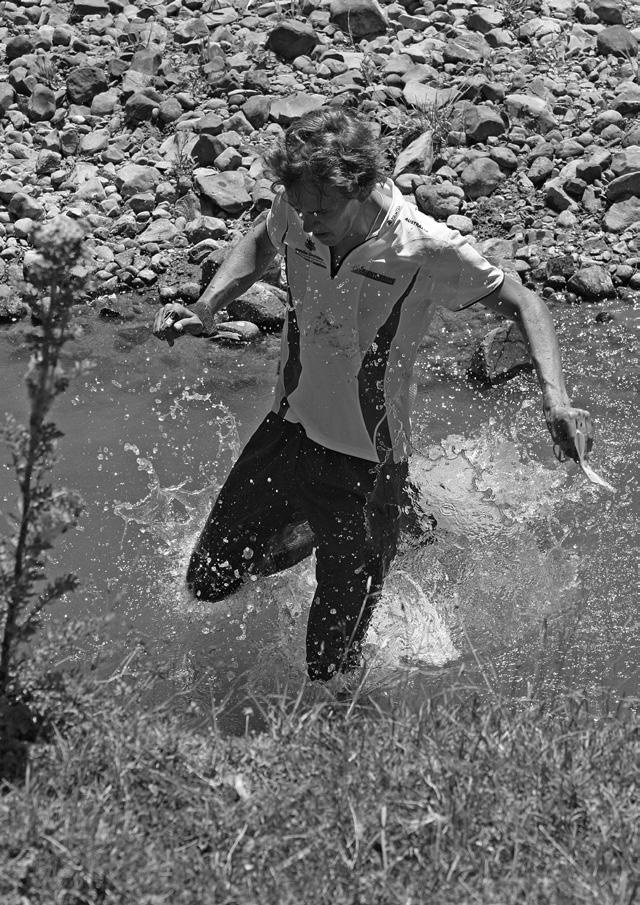
The Carnival moved to the South Kaipara peninsula, north west of Auckland. The second World Ranking Event and third test match was held on the flat to rolling Woodhill sand-dunes with areas of intricate contour detail. The forest was a mix of mature pine with good visibility and younger pines with low visibility which tested most competitors early on in their courses. The terrain suited the home team more than the visitors, and as a result New Zealand won the third test match by a convincing 63-34. It was noted in the program mapping comments that the area contained some large open areas which used to be lakes but were now overgrown with vegetation and although they appeared as open they were in fact impassable and as a result had been mapped as solid green. Despite this warning, after losing contact with the map in a particularly tricky area, ACT’s Hugh Moore, another veteran Waitangi competitor, decided to prove both the mapper and course setter wrong by successfully going straight though the middle of one such area! Ross Morrison continued his winning ways finishing in 31min35sec, almost two minutes clear of fellow countryman Darren Ashmore on the 4.9km course. David Shepherd was the fastest of the Australians taking third place in 34min15sec. New Zealand’s Lizzie Ingham blitzed the women’s field with an impressive 34min51sec, nearly four minutes ahead of Australia’s Anna Sheldon who took second place.
Event 9 - Multi Day Distance - Karepiro Beach
After seven days of great orienteering in great weather, the last day was marred a little by poor weather but more so by cancellation of the two elite courses held on the Weiti Station Forest map north of Auckland. Carnival event organiser Simon Addison said both teams had complained about control placement and inconsistent mapping which had resulted in an unfair competition. The jury upheld a complaint lodged by both teams. The final test match score was based on the first three races giving New Zealand the win 149 121 and the Key-Aspin Trophy. As suggested by the map name, the area was bounded on one side by Karepiro beach, and while the weather remained cool and damp throughout the morning and early afternoon, some competitors still found it warm enough to take an ocean dip after their race. Having competed in the 2007 Waitangi Carnival we were looking forward to this year’s event and the expanded competitions, especially the Night Relay, and we were not disappointed. Apart from the last day elite course cancellations, the Carnival was a great success and a testimony to the dedicated number of New Zealand’s elite orienteers involved in the core organisation and to the assistance of the various clubs who helped run the events. With the staging of the 2009 Oceania Championships on New Zealand’s South Island next January, the Waitangi organisers have decided to rest the carnival for a year, but are planning to hold the event again in 2010, possibly a little earlier in January, so as not to clash with New Zealand’s return to school (and Australia’s). 2010 can’t come soon enough!
Acknowledgement: Simon Addison for article material.










